Contents
- Symptoms of infectious diseases of chickens
- Infectious diseases of chickens harmless to humans
- Symptoms and treatment of chicken diseases that are not dangerous to humans
- Possible winter diseases of chickens
- Invasive diseases of chickens
- Causes of non-communicable diseases of broilers and their elimination
Chickens are no less prone to disease than any other pets. But diseases of chickens are most often treated with an ax, since it usually becomes clear that the chicken is sick only when it is too late to help. In addition, treating a chicken will often cost more than the bird itself.
Almost all infectious diseases of chickens caused by bacteria and protozoa are treated with only one method: slaughtering diseased chickens. Only salmonellosis can be treated. At the same time, domestic chickens have more than enough diseases and they are difficult to differentiate by non-professionals, which is clearly seen in the video.
The man only managed to figure out which of the chickens it all started with. At the same time, private owners often simply do not have the opportunity to comply with the necessary quarantine and keeping chickens standards.
The main signs of a diseased chicken of any of the diseases:
Hunched back, drooping wings, drooping head and the desire to separate from the companions, huddled in a corner. The physical condition of the chicken can be determined by the color of the comb:
- red (in some breeds bright pink) comb of a healthy color – everything is in order with the blood circulation in the chicken and she is not going to die in the near future;
- light pink – something has disturbed blood circulation, the chicken is seriously ill;
- a comb with a blue tint – the chicken is going to the next world and it is better to have time to kill her before she dies herself.
Theoretically, in many cases, sick chickens are suitable for human consumption, but poultry farmers prefer to give them to dogs.
Complementing the picture are dirty feathers due to the inability of a chicken to clean itself during illness and paws swollen due to arthrosis or a tick.
The photo shows the characteristic pose of a sick chicken.
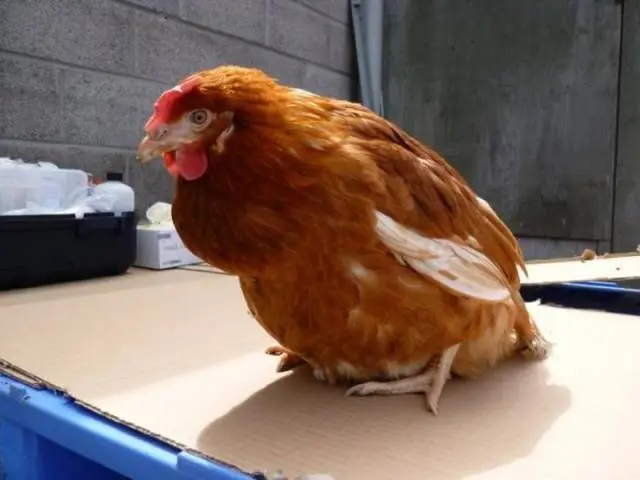
Of the infectious diseases dangerous to humans, chickens get sick:
- tuberculosis;
- pasteurellosis;
- leptospirosis;
- listeriosis;
- salmonellosis.
For the first four types of diseases, only the slaughter of the entire population of chickens is provided.
With leptospirosis, sick chickens are separated from the main livestock and treated with furazolidone and streptomycin for 3 weeks. Furazolidone is added to the water, and streptomycin is added to the feed.
Symptoms of infectious diseases of chickens
Listeriosis. The disease is caused by a microorganism: a gram-positive movable rod. The disease usually begins with conjunctivitis. Other signs in chickens include convulsions, paresis of the limbs, and eventually paralysis and death. The diagnosis is made in the laboratory.
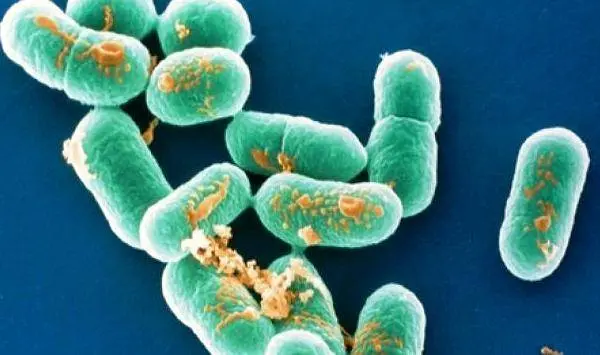
It is required to differentiate listeriosis from pasteurellosis, spirochetosis, typhoid, plague and Newcastle disease. But it makes sense to do this only in large farms. In small ones, if “hens began to wheeze”, it is easier to kill all the livestock. Moreover, with pasteurellosis or Newcastle disease, this will have to be done in any case.
Tuberculosis. In chickens, this disease usually occurs in a chronic form with implicit signs. Lethargy, exhaustion are observed, in laying hens a decrease in egg production. Diarrhea and yellowness of the mucous membranes are also possible. Sometimes there is lameness and tumor formations on the soles of the paws. The disease of tuberculosis must be able to distinguish from the subcutaneous tick and traumatic formations.
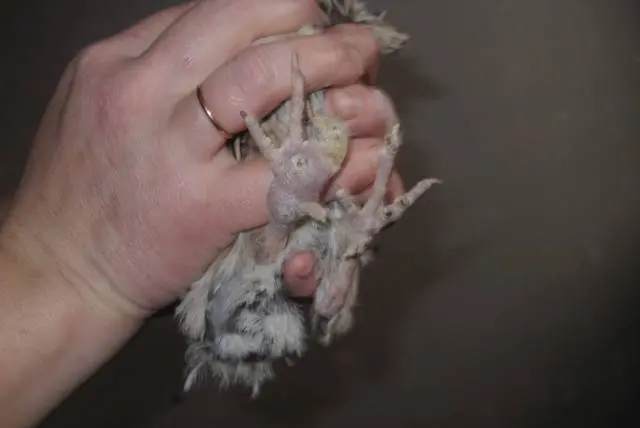
Pasteurellosis. It has 5 forms of the course of the disease with slightly different symptoms. At hyperacute form disease, an outwardly healthy chicken suddenly dies. At acute course diseases, the most noticeable sign indicating pasteurellosis will be a blue comb and earrings. In addition, chickens are observed: apathy, a disheveled chicken sits with lowered wings, wheezing when breathing, atrophy of the pectoral muscles, foam from the beak and nasal openings, thirst. The chicken dies with an acute course after 3 days.
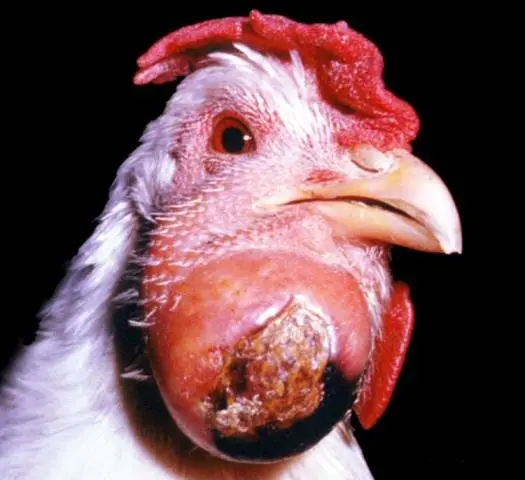
Subacute and chronic course the diseases are similar: in both forms of the disease there are arthritis of the joints, exhaustion, lethargy, inflammation of the earrings with the appearance of abscesses. The death of chickens in the subacute course of the disease occurs in a week or earlier. In the chronic course of the disease, rhinitis, inflammation of the intermaxillary space, discharge from the conjunctiva and from the nasal openings are also added to the listed signs.
The photo clearly shows a chicken comb that has turned blue with pasteurellosis.

Leptospirosis. With leptospirosis in chickens, the liver is affected, so one of the obvious symptoms of leptospirosis in chickens is yellowness of the skin and mucous membranes. In addition, there is usually weak bowel function, decreased egg production, and fever.
salmonellosis. With this disease, chickens have abundant foamy droppings of a liquid consistency, lack of appetite, thirst, and apathy. In chickens, swelling of the joints of the limbs is also noted, which should be distinguished from arthritic processes in pasteurellosis.
To protect the health of people when these diseases appear, it is better to slaughter the entire population of chickens than to try to treat the bird.
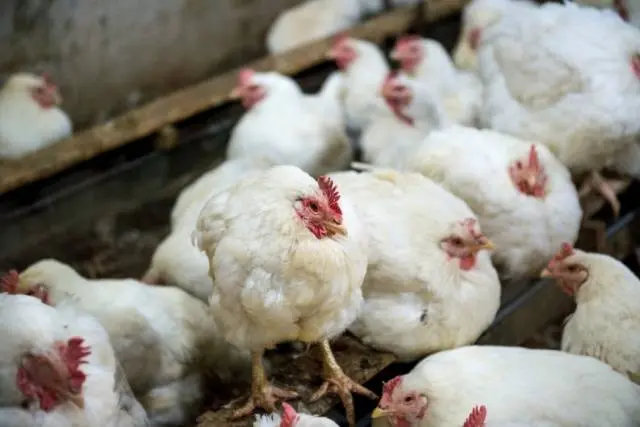
Infectious diseases of chickens harmless to humans
Diseases dangerous to humans are not the only infectious diseases that chickens can suffer from. There are also a number of infections caused by bacteria or protozoa that are not cosmopolitan:
- eimeriosis;
- purolosis (white diarrhea, chicken dysentery);
- Newcastle disease;
- egg drop syndrome;
- escherichia (colibacteriosis);
- flu;
- respiratory mycoplasmosis;
- Marek’s disease;
- infectious laryngotracheitis;
- infectious bronchitis;
- infectious bursitis;
- aspergillosis;
- metapneumovirus infection.
For most chicken diseases, treatment has not been developed, only preventive measures can be taken.
Symptoms and treatment of chicken diseases that are not dangerous to humans
Eimeriosis chickens
Eimeriosis of chickens is often called coccidiosis. Parasitic infection caused by protozoa. Chicks between 2 and 8 weeks of age are most susceptible. Therefore, do not be surprised if already grown 2-month-old chickens suddenly begin to die. They may have been infected with eimeria somewhere.
The incubation period for Eimeria is 3 to 5 days. As a rule, chickens have an acute course of the disease, which is manifested by oppression, a sharp decrease in appetite, followed by a complete refusal of food, thirst. Chickens huddle together, trying to keep warm. The wings are down. The feathers are ruffled. The death of the bird usually occurs 2 to 4 days after the onset of clinical signs and can reach 100%. In many ways, the severity of the course of the disease depends on the number of parasites that have entered the body of the bird. With a small number of oocysts, Eimeria coccidiosis in chickens will be asymptomatic, with the possible subsequent development of immunity to Eimeria.

Treatment of the disease
When the first signs of the disease appear, the entire population of chickens is soldered with coccidiostatics, which are divided into two groups. One group prevents the development of immunity to hens’ eimeriosis and is used in broiler farms, where the bird receives coccidiostatic continuously almost until the date of slaughter. The dacha of this group of coccidiostats is stopped 3-5 days before slaughter.
The second group of drugs allows you to develop immunity in chickens and is used in breeding and egg farms. It is also most suitable for private traders who often keep chickens for eggs than broilers for slaughter.
Different drugs against eimeria have different dosages and courses of treatment, therefore, when treating chicken eimeria, you should follow the instructions on the drug or the instructions of the veterinarian.
disease prevention
Eimeria get to the poultry house not only with the droppings of a sick bird or rodents, but also with the shoes and clothes of the attendants. Direct infection with eimeria occurs through water and feed contaminated with oocysts. Therefore, for prevention, it is necessary to observe the veterinary and hygienic rules for keeping chickens. Do not allow bird droppings to enter water or feed. Keep chickens in cages with mesh floors that are easy to disinfect. Since Eimeria are very resistant to adverse factors, the best way to disinfect is to bake the equipment in the house with a blowtorch.
Newcastle disease
This viral disease has several names:
- Asian bird plague;
- pseudo-plague;
- filaret disease;
- renikhet disease;
- abbreviation from the main name – NB.
The virus is quite stable in the external environment, and is also capable of intrauterine penetration into the chicken egg and survival in the egg during the entire period of incubation. Thus, the chicken may be born already sick.
Symptoms of the disease
In the disease, 3 types of the course of the disease are distinguished, as well as typical and atypical forms. With a superacute course of the disease, the infection affects the entire chicken coop in 2-3 days with obvious clinical signs. Since the virus affects the nervous system of birds, the symptoms are neck twisting, paralysis of the limbs, impaired coordination of movements, excitability, and difficulty breathing.
In a typical form of the acute course of the disease, 70% of the chicken population may experience suffocation, and 88% – diarrhea. Mucus from the beak, conjunctivitis, poor appetite, fever of 1-2 degrees. Often the bird lies with its beak on the floor and does not react to the environment.
The atypical form of the disease develops where antibiotics are widely used and there are birds with immunity of different strengths in the herd. In this case, Newcastle disease usually occurs without characteristic clinical signs, affecting mainly young chickens.
The percentage of death of chickens with this disease reaches 90%. Treatment has not been developed and will most likely not be developed due to the high risk of Newcastle disease.
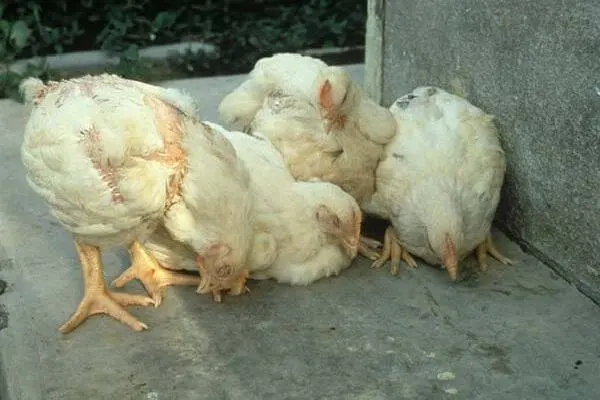
Prevention of disease
The main way to prevent the development of the disease is to comply with sanitation standards. If possible, with the threat of a disease, chickens are vaccinated with La Sota, BOR-74 VGNKI or a vaccine from the B1 strain.
plague of chickens
Other names for the disease: flu and influenza. The bird is not treated, since the disease immediately takes the form of an epizootic, which can only be stopped by slaughtering the entire sick population of chickens.
Symptoms of the disease
Distinguish the course of the disease of varying severity.
In severe cases, the development of the disease is very rapid, the temperature rises to 44 °, falling to 30 ° before death. Mucous edematous, expiration from the nose. Blue earrings and comb, which looks like pasteurellosis. Chickens are depressed and inactive, quickly fall into a coma, dying 24-72 hours after the onset of clinical signs. Mortality 100%.
With moderate severity, the disease lasts a week. Weakness, frequent shallow breathing, depression are observed. Mucous discharge from nose and beak, goiter atony. Diarrhea develops yellow-green color. With an average and mild course of the disease, up to 20% of chickens die. Laying hens on the floor endure influenza more severely, productivity decreases by an average of 50%, recovering after recovery.
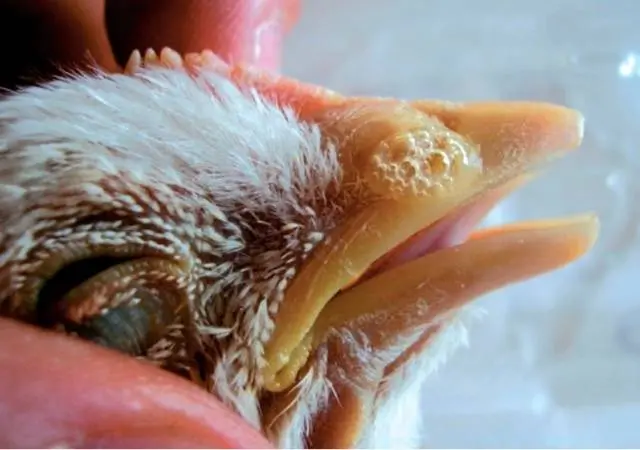
disease prevention
Vaccination of chickens and quarantine of suspect farms.
Marek’s disease
Other names: bird paralysis, neuritis, neurolymphomatosis, infectious neurogranulomatosis. Viral disease. The causative agent is one of the forms of herpes viruses. The virus is stable in the environment, but is very sensitive to common disinfectants: phenol, lysol, alkalis, formaldehyde and chlorine.
Symptoms of the disease
The incubation period of the disease can reach 150 days. The symptoms of the acute form of the disease are similar to those of leukemia: abnormal positions of the head, limbs and body, exhaustion, a sharp decrease in egg production, apathy. Lethal outcome occurs in 46% of diseased chickens. The acute form of the disease is observed in farms already disadvantaged in the classical form.
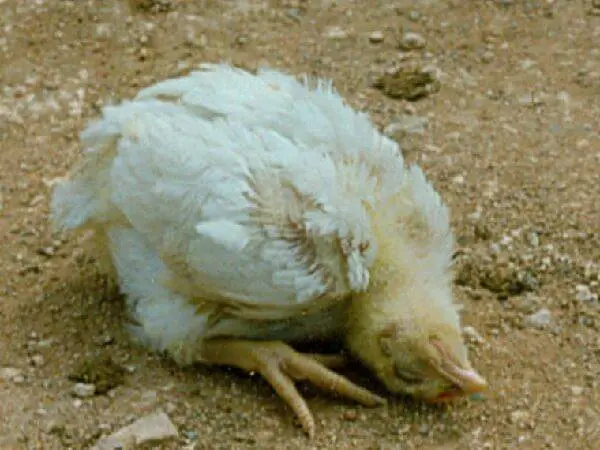
The course of the classical form of the disease is expressed in the defeat of the nervous system: paralysis, lameness, paresis, the eyes of chickens become gray, and the shape of the pupil becomes pear-shaped or star-shaped. There is total blindness. The incubation period for the classic form of the disease can also be up to 150 days. Lethal outcome up to 30% of sick birds.
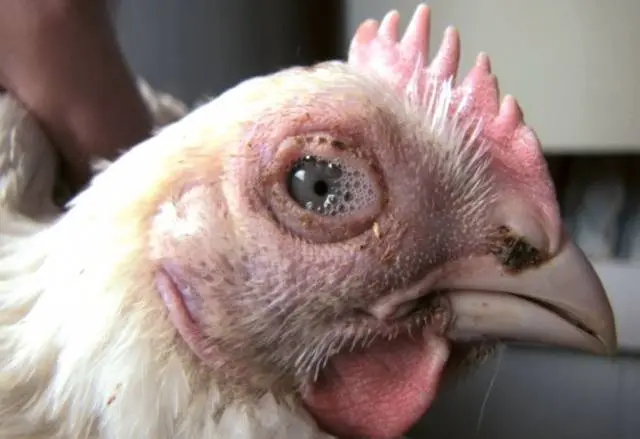
There is no treatment for this disease.
The video clearly shows the external signs of Marek’s disease and the results of the autopsy of a chicken that died from Marek’s disease
disease prevention
The main measures for the prevention of Marek’s disease are the vaccination of chicken stock with live vaccines. There are two types of vaccines: from strains of the Marek’s disease virus and strains of the turkey herpes virus. Also, for the prevention of Marek’s disease, eggs for incubation are imported only from prosperous farms. Strictly observe the requirements of hygiene rules in poultry houses. When the Marek’s disease virus is affected, 10% of the chicken population slaughter the entire bird, followed by thorough disinfection of the premises. But it is better to breed chickens from lines resistant to Marek’s disease.
Leukemia of chickens
It is caused by oncoviruses and most often affects chickens older than 4 months. Symptoms of the disease are non-specific, the main ones are: emaciation, decreased egg production, diarrhea, scallop anemic. Tumors in chickens can form anywhere, but mainly in the pectoral muscles, under the skin and in the skin.
There is no cure. Suspicious chickens are isolated and slaughtered. As a prophylaxis of the disease, young chickens and hatching eggs are taken from farms that are safe for leukemia.
Infectious laryngotracheitis of chickens
Viral disease. The virus is relatively stable in the environment, but is very sensitive to common disinfectants.
The death of chickens with this disease occurs from suffocation.
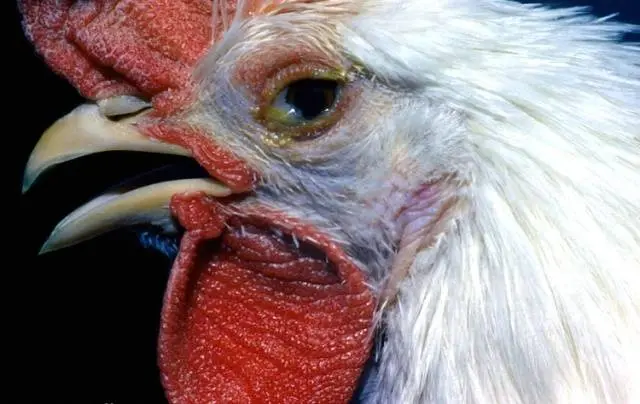
Symptoms of the disease
The disease has 4 types of course. In the acute course of the disease, inflammation of the trachea, blockage of the larynx, cough, wheezing are observed. Egg production stops. Lethal outcome 15%.
With a superacute course of the disease, the main symptoms are coughing up mucus and blood. The percentage of deaths is 50%.
In chronic and subacute courses, the disease takes a long period of time, during which the chickens become either better or worse. These forms are characterized by conjunctivitis, wheezing, cough, shortness of breath. The death of chickens in these cases reaches 7%.
There is an atypical form of the disease, of the visible signs of which there are only symptoms of conjunctivitis. With this form, with good feeding and care, most chickens recover. Under unfavorable conditions, almost the entire livestock of the poultry house dies, since secondary infections strongly affect the severity of diseases in chickens and their mortality.
Treatment and prevention of the disease
As such, the treatment of the disease has not been developed. To prevent complications in chickens and treat them in case of infection with a secondary infection, broad-spectrum antibiotics are used, spraying them into the air.
The main measure for the prevention of the disease is to prevent the introduction of infection into the economy. In the event of an outbreak of the disease, sick and suspicious chickens are slaughtered, the room is disinfected.
Infectious bronchitis of chickens
The virus infects the respiratory and reproductive organs, reducing egg production. When using disinfectants, the virus dies after 3 hours.
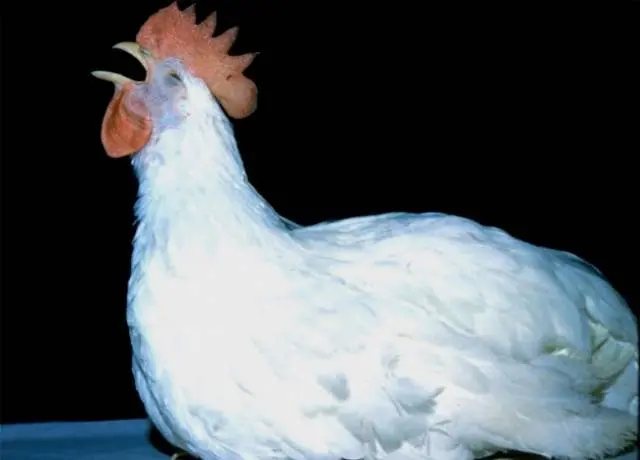
Symptoms of the disease
Symptoms of IB include: shortness of breath, sneezing, conjunctivitis, loss of appetite, difficulty breathing with wheezing, lethargy, open beak. When the respiratory system is affected, the disease is acute and the percentage of death reaches 33%. When the reproductive organs are damaged, egg production decreases, eggs with deformations on the shell, the hatchability of chickens also decreases. With damage to the kidneys and ureteral tubules, diarrhea and depression are observed. Mortality reaches 70% of the number of diseased chickens.
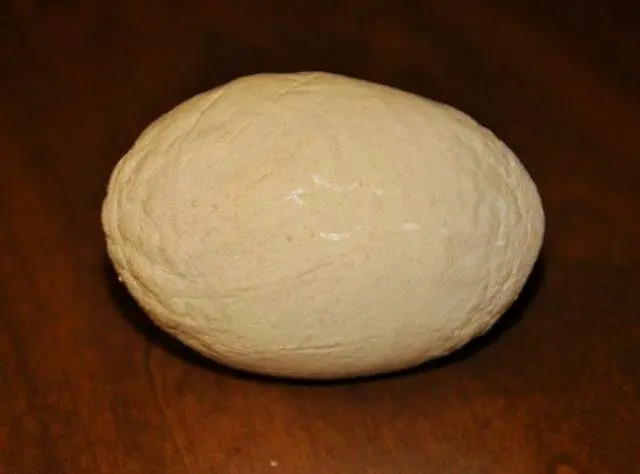
Prevention of disease
There is no treatment. Prevention of the disease traditionally consists in the purchase of breeding material for chicken herds in prosperous farms, as well as the use of a dry vaccine of the AM strain.
Infectious bursitis of chickens
With the disease, the joints become inflamed, intramuscular hemorrhages appear, and the kidneys are affected. Treatment has not been developed.
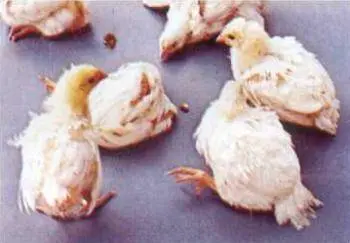
Symptoms of the disease
In the acute course, the disease affects 100% of susceptible individuals of all ages. This is especially true for broiler chickens aged 2 to 11 weeks. Diarrhea, loss of appetite, trembling in the body, depression, loss of the ability to move first appear. Later, anorexia, white diarrhea is added (can be confused with pullorosis). Mortality can reach 40%, although usually only 6% of the total number of chickens die.
In chronic latent course of bursitis, its signs may be an atypical course of other viral and infectious diseases.
Prevention of the disease is the completion of the main herd of chickens with healthy individuals.
Egg Drop Syndrome-76
A viral disease in which egg production decreases, the shape of eggs changes, the quality and pigmentation of the shell changes, and the quality of egg white deteriorates.
This disease has two groups of viruses. The first affects broiler breeds and causes little damage. The second group causes a disease that causes serious economic damage to poultry farms.
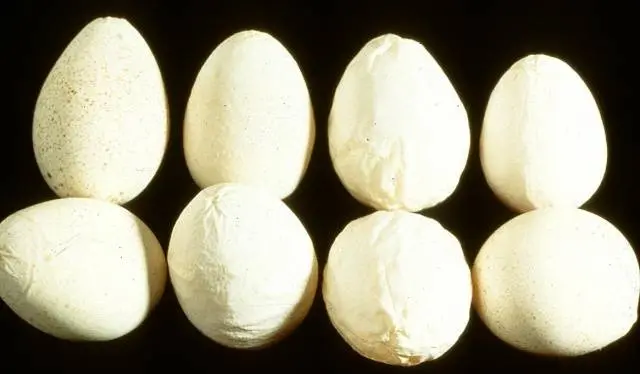
Symptoms of the disease
There are no characteristic signs of the disease. Diarrhea, ruffled plumage, prostration are noted. In the later stages of the disease, blue wattles and scallops are possible, but this is not observed in all chickens. For 3 weeks, hens lay defective eggs. At the same time, egg production of chickens is reduced by 30%. With the cellular content of chickens, it is possible to restore productivity.
Prevention of disease
There is no treatment. As a prophylaxis, laying hens are vaccinated at the age of 20 weeks. Positively reacting chickens are slaughtered.
In addition to the diseases already listed, there are many others. Common to almost all diseases is one thing: the treatment of an infectious disease for chickens has not been developed. In addition, many diseases have similar symptoms and it is difficult for a private poultry farmer without education and a laboratory to distinguish one disease from another. And since in the vast majority of cases a panacea for all diseases is used: an ax, you don’t have to worry about the question of which viruses or bacteria visited the chicken coop.
Possible winter diseases of chickens
Diseases of laying hens in winter are caused by overcrowding in the winter chicken coop and a lack of vitamins and trace elements. The most common chicken disease in winter, eimeriosis, is caused precisely by crowding of livestock in a small area.
If the decrease in egg production in winter is most likely due to short daylight hours, then pecking of eggs, and sometimes pulling out feathers and pecking the body to meat, can be caused by stress or a lack of trace elements.
With stress caused by too dense planting of chickens per unit area, the chickens are organized for walks in the aviary, driving them into the chicken coop only for the night. The rest of the time, chickens are free to enter and leave the barn.
When self-pecking and eating eggs, chickens add fodder chalk and fodder sulfur to the diet.
Usually, if the addition of chalk and sulfur does not save the eggs from pecking, the pest chicken is slaughtered.
“Sit on their paws”, if it’s not an infection, it comes precisely from a lack of movement, and keeping chickens all winter in a closed chicken coop adversely affects the respiratory system, which becomes noticeable when the owners open the sheds in the spring and release the chickens into the street.
To prevent most winter diseases, it will be enough to provide chickens with walking and a balanced diet.
Invasive diseases of chickens
Diseases caused by parasites. These diseases develop well in crowded conditions. Invasive diseases include:
- arachnosis;
- helminthiases;
- pereeda.
When infected with a feather, the bird feels itching on the body and tries to get rid of it by tearing the feather out of itself.
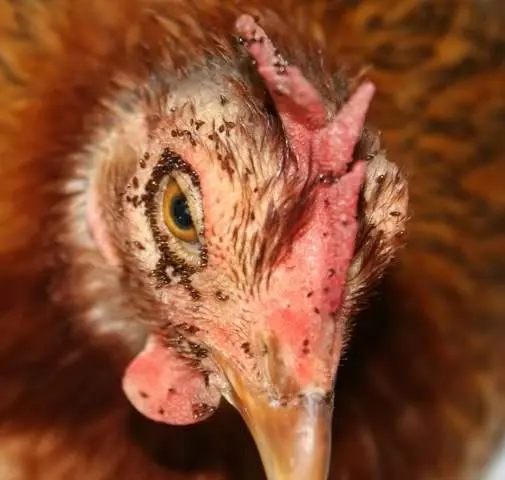
The pereater is a large enough insect that it can be detected even with the naked eye. And sometimes feel how he crawls on the hand. Like any skin parasite, the period is easily removed by any means for animals from ticks and fleas. In fact, this is a chicken analogue of fleas and withers that parasitize mammals.
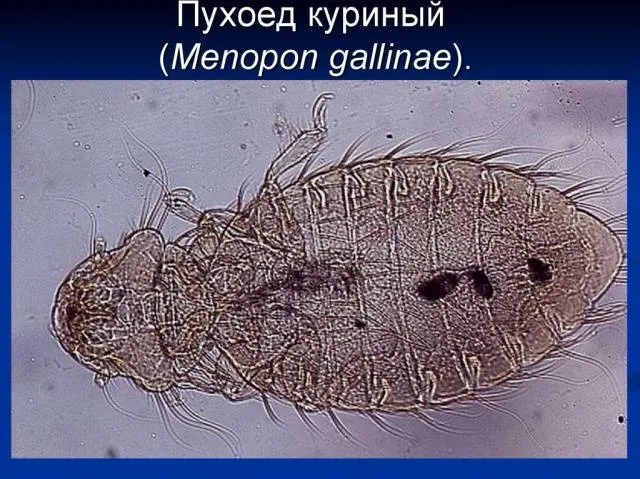
Helminthiases are treated with anthelmintic drugs according to the scheme indicated separately for each drug. For preventive purposes, deworming in chickens is carried out every 4 months.
Knemidokoptosis or scabies mite can parasitize in chickens under the scales on the paws, causing tumors, or in the feather follicles, because of which the bird begins to itch and tear out the feather. Acaricidal preparations work well against it, which can be bought at a pharmacy or asked from a veterinarian.
In the photo, a chicken paw infected with a tick.

Causes of non-communicable diseases of broilers and their elimination
The causes of non-communicable diseases in broilers are usually non-compliance with the temperature regime or the regime and diet of feeding.
Enteritis can be a sign of an infectious disease. Other diseases: gastritis, dyspepsia, cuticulitis, are usually the result of an unbalanced diet or low-quality feed. Eliminating the causes of these diseases is simple, it is enough to transfer chickens to high-quality factory feed in order to exclude contamination of home-made feeds with pathogenic microorganisms. Factory feed should also be stored in a cool, dry place.
Bronchopneumonia is a consequence of hypothermia in chickens, provided that a secondary infection enters the respiratory tract. They are treated with antibiotics.
Signs of hypothermia: frothy discharge from the eyes and nasal openings of the beak. In addition, such a chicken trembles all over. A simple cold goes away in a couple of days in a box with an air temperature of about 40 degrees.
Frozen chickens squeak and try to huddle together. In this case, the room temperature must be increased.
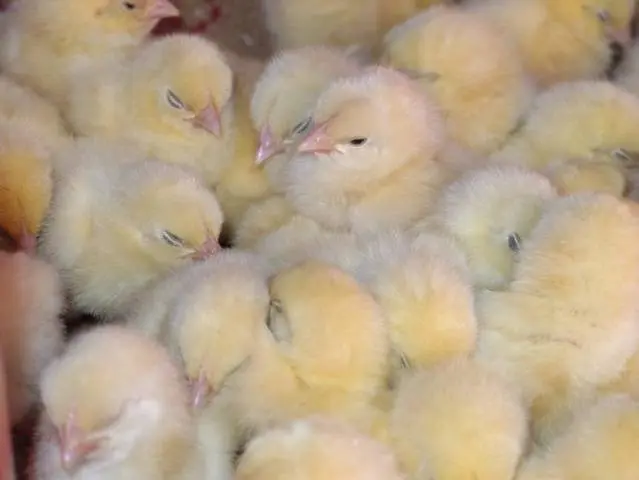
When overheated, chickens try to get as far away from the heat source as possible. Sedentary. They often lie with their beaks on the floor. The temperature is reduced.
Despite the number of diseases that are detrimental to an individual, the chicken as a species is not going to give way to any other poultry. And in fact, subject to the necessary sanitary standards, chicken diseases are not as terrible as they might seem. Although one must be prepared for the loss of the entire chicken population.










20 دن کا بچہ ہے مرغی کا وہ بیمار ہو گیا ہے اس کے گلے
اور اس کا جسم بھی گرم ہے سے کھرکھراہٹ کی آواز آتی ہیں